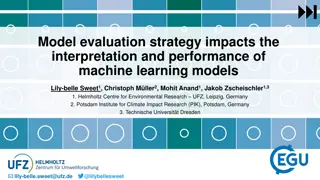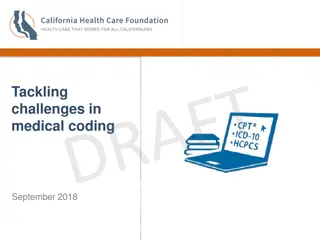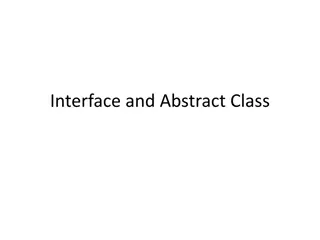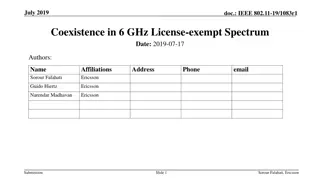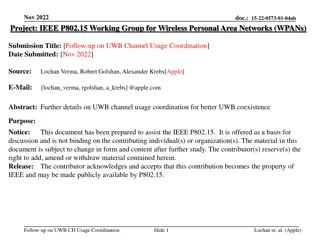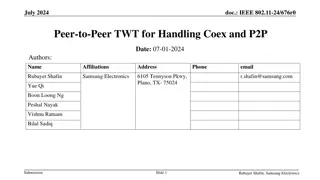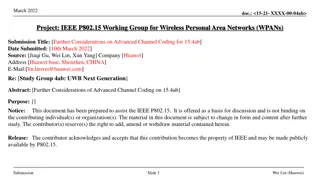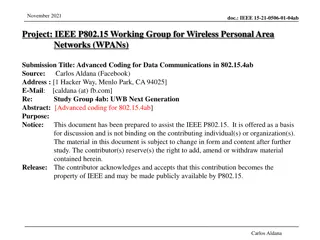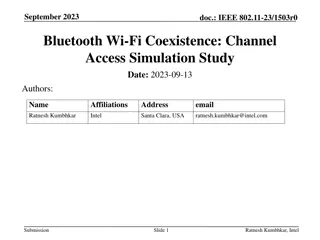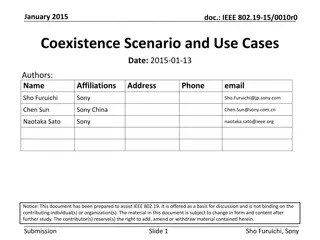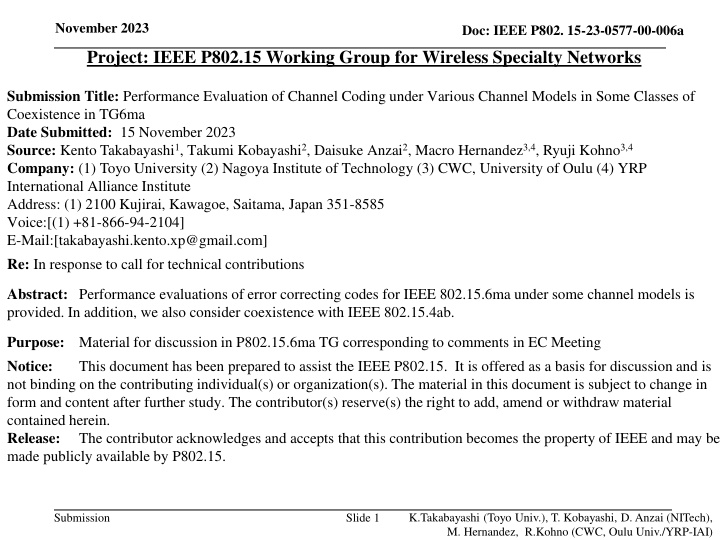
Performance Evaluation of Channel Coding in Wireless Networks Coexistence
Explore the performance evaluation of error correcting codes in IEEE 802.15.6ma under various channel models and coexistence scenarios with IEEE 802.15.4ab. The document highlights the importance of quality of service control in WBAN systems, emphasizing optimal error control for sensor data transmission procedures. Presented at an IEEE event with contributions from multiple universities and institutions.
Uploaded on | 3 Views
Download Presentation

Please find below an Image/Link to download the presentation.
The content on the website is provided AS IS for your information and personal use only. It may not be sold, licensed, or shared on other websites without obtaining consent from the author. If you encounter any issues during the download, it is possible that the publisher has removed the file from their server.
You are allowed to download the files provided on this website for personal or commercial use, subject to the condition that they are used lawfully. All files are the property of their respective owners.
The content on the website is provided AS IS for your information and personal use only. It may not be sold, licensed, or shared on other websites without obtaining consent from the author.
E N D
Presentation Transcript
November 2023 Doc: IEEE P802. 15-23-0577-00-006a Project: IEEE P802.15 Working Group for Wireless Specialty Networks Submission Title: Performance Evaluation of Channel Coding under Various Channel Models in Some Classes of Coexistence in TG6ma Date Submitted: 15 November 2023 Source: Kento Takabayashi1, Takumi Kobayashi2, Daisuke Anzai2, Macro Hernandez3,4, Ryuji Kohno3,4 Company: (1) Toyo University (2) Nagoya Institute of Technology (3) CWC, University of Oulu (4) YRP International Alliance Institute Address: (1) 2100 Kujirai, Kawagoe, Saitama, Japan 351-8585 Voice:[(1) +81-866-94-2104] E-Mail:[takabayashi.kento.xp@gmail.com] Re: In response to call for technical contributions Abstract: Performance evaluations of error correcting codes for IEEE 802.15.6ma under some channel models is provided. In addition, we also consider coexistence with IEEE 802.15.4ab. Purpose: Notice: not binding on the contributing individual(s) or organization(s). The material in this document is subject to change in form and content after further study. The contributor(s) reserve(s) the right to add, amend or withdraw material contained herein. Release: The contributor acknowledges and accepts that this contribution becomes the property of IEEE and may be made publicly available by P802.15. Material for discussion in P802.15.6ma TG corresponding to comments in EC Meeting This document has been prepared to assist the IEEE P802.15. It is offered as a basis for discussion and is K.Takabayashi (Toyo Univ.), T. Kobayashi, D. Anzai (NITech), M. Hernandez, R.Kohno (CWC, Oulu Univ./YRP-IAI) Submission Slide 1
Doc: IEEE P802. 15-23-0577-00-006a November 2023 Performance Evaluation of Channel Coding under Various Channel Models in Some Classes of Coexistence in TG6ma November 2023, Hybrid Session , Hilton Hawaiian Village Waikiki - Honolulu, HI Kento Takabayashi(1), Takumi Kobayashi, Daisuke Anzai(2), Macro Hernandez, Ryuji Kohno(3,4) (1)Toyo University, (2) Nagoya Institute of Technology, (3)CWC, University of Oulu, (4) YRP-International Alliance Institute K.Takabayashi (Toyo Univ.), T. Kobayashi, D. Anzai (NITech), M. Hernandez, R.Kohno (CWC, Oulu Univ./YRP-IAI) Submission Slide 2
Doc: IEEE P802. 15-23-0577-00-006a November 2023 Importance of QoS control In WBAN systems, a wearable vital sign sensor node can include various types of sensors with different data rates, the allowable communication error ratio and delay User priority Traffic designation Frame type 0 Background (BK) Data 1 Best effort (BE) Data 2 Excellent effort (EE) Data IEEE 802.15.6 based WBAN may deal with 8 levels of user priority data 3 Video (VI) Data 4 Voice (VO) Data 5 Medical data or network control Data or management Those data have a wide range of quality of service (QoS) 6 High-priority medical data or network control Data or management 7 Emergency or medical implant event report Data Therefore, optimal error control for input data is an important feature in sensor data transmission procedures Submission Slide 3 K.Takabayashi (Toyo Univ.), T. Kobayashi, D. Anzai (NITech), M. Hernandez, R.Kohno (CWC, Oulu Univ./YRP-IAI)
Doc: IEEE P802. 15-23-0577-00-006a November 2023 Error control in current IEEE 802.15.6 IEEE 802.15.6 shall use a (63, 51) BCH code as an error correcting code in narrowband, UWB and HBC PHY Only user priority 6 data in UWB-PHY may use a hybrid ARQ with a (126, 63) shortened BCH code However, the error control scheme of the current IEEE 802.15.6 cannot deal with the QoS because of lack of flexibility In IEEE 802.15.6ma, we indicate a concept of channel coding technique to deal with various types of QoS data as shown in a next figure Submission Slide 4 K.Takabayashi (Toyo Univ.), T. Kobayashi, D. Anzai (NITech), M. Hernandez, R.Kohno (CWC, Oulu Univ./YRP-IAI)
Doc: IEEE P802. 15-23-0577-00-006a November 2023 Concept of channel coding for PSDU In a low priority QoS case, only a single error correcting code will be applied for PSDU In a high priority QoS case, an outer and an inner error correcting codes will be serially applied for PSDU MPDU is encoded by CRC-16-CCITT to detect bit errors Submission Slide 5 K.Takabayashi (Toyo Univ.), T. Kobayashi, D. Anzai (NITech), M. Hernandez, R.Kohno (CWC, Oulu Univ./YRP-IAI)
Doc: IEEE P802. 15-23-0577-00-006a November 2023 Table for Concept User priority Inner code Outer code HARQ 0 15.4ab LDPC or BCC (R=1/2) - 1 15.4ab LDPC or BCC (R=1/2) - 2 15.4ab LDPC or BCC (R=1/2) - 3 15.4ab LDPC or BCC (R=1/2) - 4 15.4ab LDPC or BCC (R=1/2) (54, 46) shortened RS code - 5 15.4ab LDPC or BCC (R=1/2) (54, 38) shortened RS code - 6 15.4ab LDPC or BCC (R=1/2) (54, 28) shortened RS code - 7 15.4ab LDPC or BCC (R=1/2) (54, 14) shortened RS code - As an outer code, shortened Reed-Solomon (RS) codes with N=54 (original code length N=63) will be selected to correct burst errors due to interference from other WBANs and the coding rates are changed according to each QoS and channel condition As an inner code, 15.4ab LDPC (K=324, 648, 972, R=1/2) or BCC will be selected for the coexistence of 15.6ma and 15.4ab This updated concept table is considered as the first priority Submission Slide 6 K.Takabayashi (Toyo Univ.), T. Kobayashi, D. Anzai (NITech), M. Hernandez, R.Kohno (CWC, Oulu Univ./YRP-IAI)
Doc: IEEE P802. 15-23-0577-00-006a November 2023 Evaluations (Only RS) Bit error ratio of (54,46), (54,38), (54,28), (54,14) shortened RS codes and no encoding were evaluated under an AWGN channel and BPSK modulation Performances were improved as the coding rate decreased Submission Slide 7 K.Takabayashi (Toyo Univ.), T. Kobayashi, D. Anzai (NITech), M. Hernandez, R.Kohno (CWC, Oulu Univ./YRP-IAI)
Doc: IEEE P802. 15-23-0577-00-006a November 2023 Evaluations (BCC and RS) Inner code: BCC (R=1/2), soft decision Viterbi decoding Outer code: (54,46), (54,38), (54,28), (54,14) shortened RS codes and no encoding Performances were improved as the coding rate of the RS codes decreased Low coding rate cases was able to correct a lot of bit errors AWGN channel and BPSK modulation Submission Slide 8 K.Takabayashi (Toyo Univ.), T. Kobayashi, D. Anzai (NITech), M. Hernandez, R.Kohno (CWC, Oulu Univ./YRP-IAI)
Doc: IEEE P802. 15-23-0577-00-006a November 2023 Evaluations (LDPC and RS) Inner code: LDPC (N=1296-bit, R=1/2) Outer code: (54,46), (54,38), (54,28), (54,14) shortened RS codes and no encoding There was almost no change in performance regardless of the coding rate of the RS code Next slide adds another element to check the effectiveness of these combinations AWGN channel and BPSK modulation Submission Slide 9 K.Takabayashi (Toyo Univ.), T. Kobayashi, D. Anzai (NITech), M. Hernandez, R.Kohno (CWC, Oulu Univ./YRP-IAI)
Doc: IEEE P802. 15-23-0577-00-006a November 2023 Evaluations (LDPC and RS) Inner code: N=1296-bit (R=1/2) LDPC code Outer code: (54,46), (54,38), (54,28), (54,14) shortened RS codes and no encoding Performances were improved as the coding rate of the RS code decreased Low coding rate cases could correct a lot of error and erasure AWGN channel and BPSK modulation Burst erasure occurs at 32.5% of the code length of the LDPC code (70 consecutive 6-bit erasures) Submission Slide 10 K.Takabayashi (Toyo Univ.), T. Kobayashi, D. Anzai (NITech), M. Hernandez, R.Kohno (CWC, Oulu Univ./YRP-IAI)
Doc: IEEE P802. 15-23-0577-00-006a November 2023 Considering Shadowing Case The PDF of shadowing in path-loss is as follows: 1 2??s2exp 2 ? ?s 2?s2 ? ? = From the above, the voltage amplitude ratio follows a log-normal distribution, and the PDF is as follows: 2 ln? ?s 1 ? 2 ? ? = exp 2?s 2 ?s ? 2? ? ? PDF of log-normal distribution (? = 0,? = 0.31) ?s: mean of shadowing [dB] ?s: standard deviation of shadowing [dB] ? =?s ? =?s ?: mean of logarithmic amplitude ratio ?: standard deviation of logarithmic amplitude ratio Submission Slide 11 K.Takabayashi (Toyo Univ.), T. Kobayashi, D. Anzai (NITech), M. Hernandez, R.Kohno (CWC, Oulu Univ./YRP-IAI)
Doc: IEEE P802. 15-23-0577-00-006a November 2023 Evaluation (Shadowing Case) BPSK modulation AWGN and Shadowing w/o coding Only RS Only LDPC RS parameter Code length: 324 bits LDPC parameter Code length: 1296 bits Fading parameter Variance: 2.69 [dB] Submission Slide 12 K.Takabayashi (Toyo Univ.), T. Kobayashi, D. Anzai (NITech), M. Hernandez, R.Kohno (CWC, Oulu Univ./YRP-IAI)
Doc: IEEE P802. 15-23-0577-00-006a November 2023 Summary of Concept Tables Inner code: 15.4ab BCC and LDPC codes (R=1/2, K=324, 648, 972) Outer code: Shortened RS code (N=54, K=46, 38, 28, 14, original code length N=63) A hybrid ARQ shall not be utilized under coexistence environment class 0~6 Shortened RS codes outperform only half-rate LDPC code in the case of the shadowing channel and high SNR We aim to evaluate the proposed combination in other practical channel models Submission Slide 13 K.Takabayashi (Toyo Univ.), T. Kobayashi, D. Anzai (NITech), M. Hernandez, R.Kohno (CWC, Oulu Univ./YRP-IAI)
July 2023 Doc: IEEE P802. 15-23-0577-00-006a Thank you for your attention ! ! ! K.Takabayashi (Toyo Univ.), T. Kobayashi, D. Anzai (NITech), M. Hernandez, R.Kohno (CWC, Oulu Univ./YRP-IAI) Submission Slide 14
Doc: IEEE P802. 15-23-0577-00-006a November 2023 Another evaluation Inner code: N=1296-bit (R=1/2) LDPC code Outer code: (54,46), (54,38), (54,28), (54,14) shortened RS codes and no encoding Performances were improved as the coding rate of the RS code decreased AWGN channel (SNR=10dB) and BPSK modulation, burst erasure occurs at 30~40% of the code length of the LDPC code (65-86 consecutive 6-bit erasures) Submission Slide 15 K.Takabayashi (Toyo Univ.), T. Kobayashi, D. Anzai (NITech), M. Hernandez, R.Kohno (CWC, Oulu Univ./YRP-IAI)





